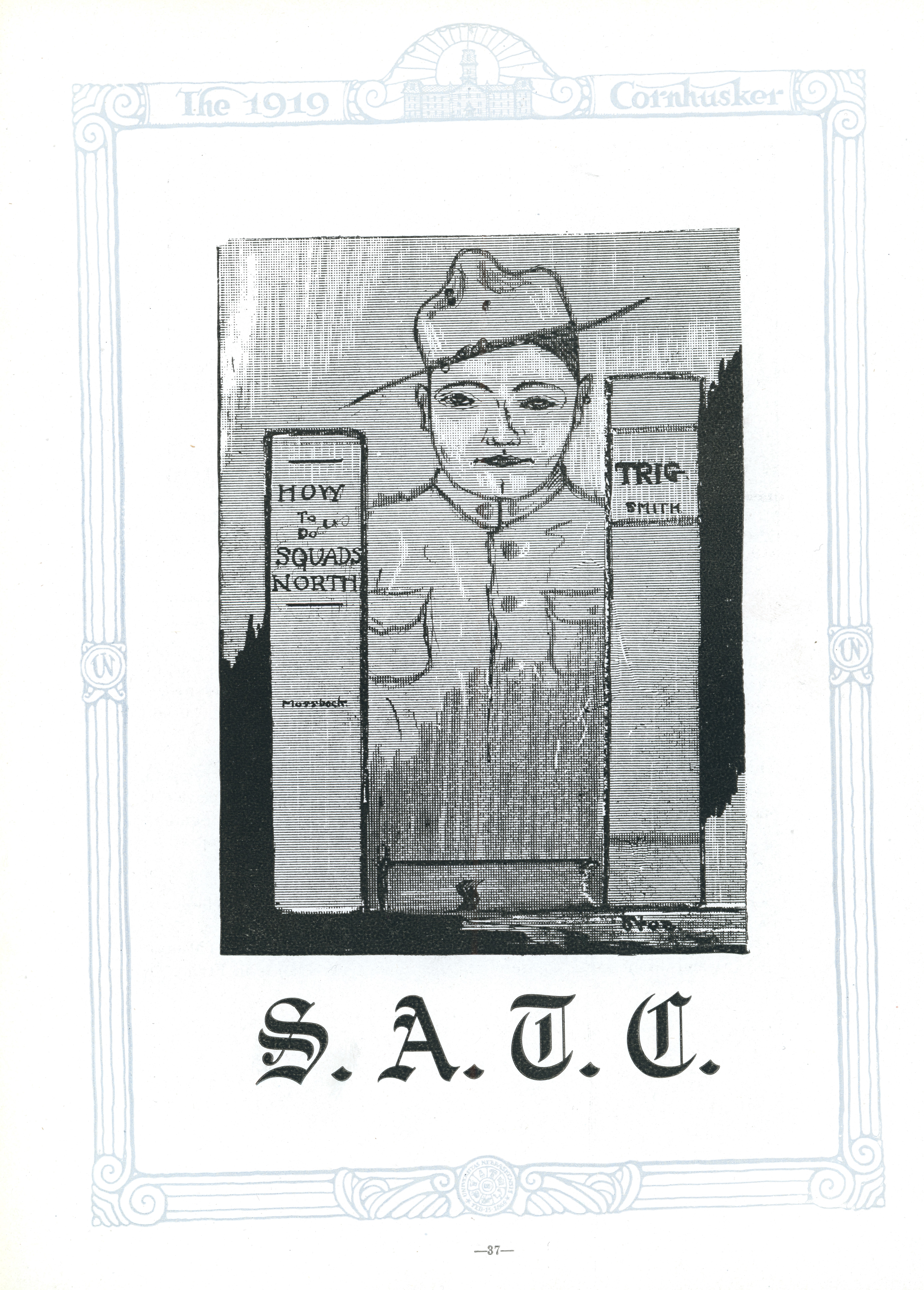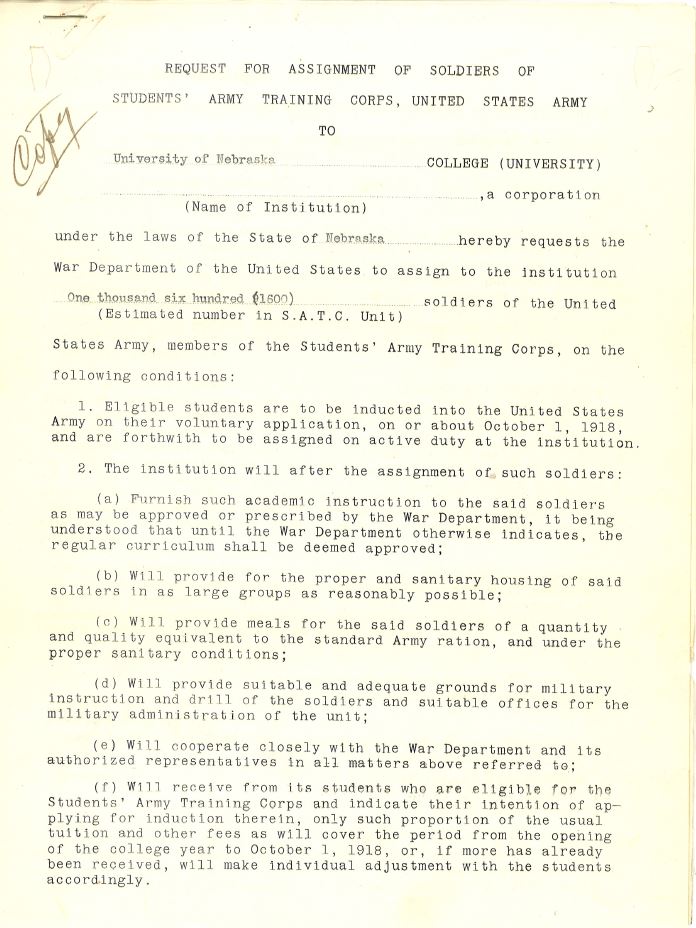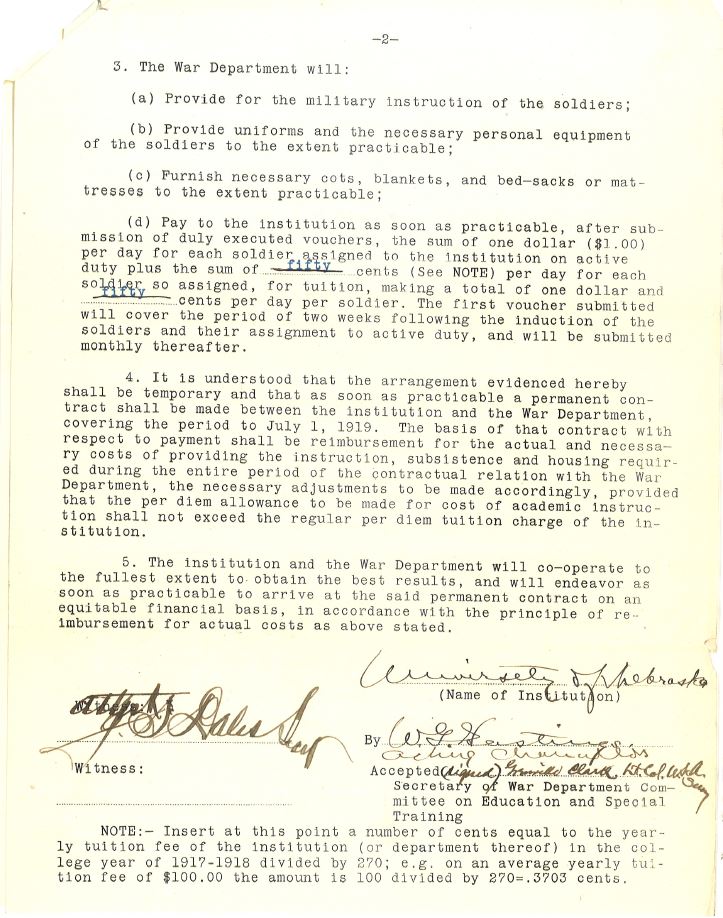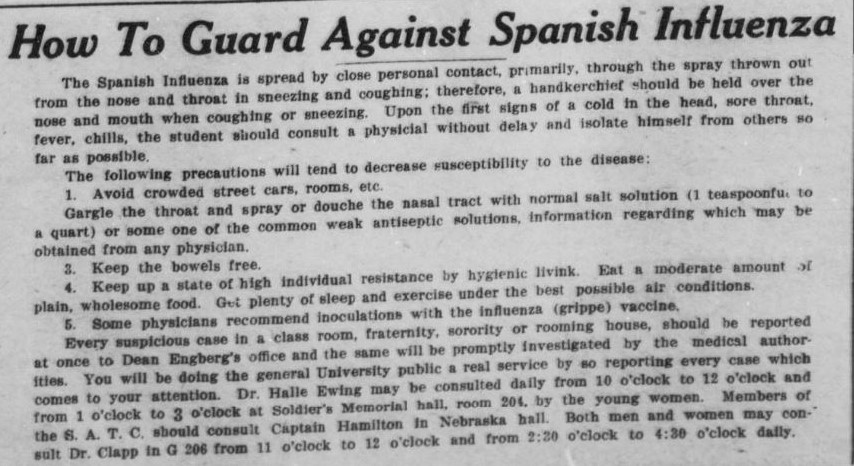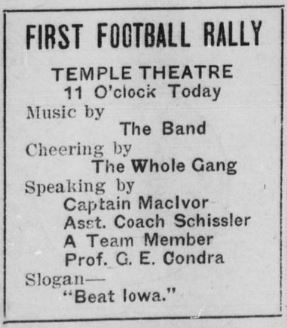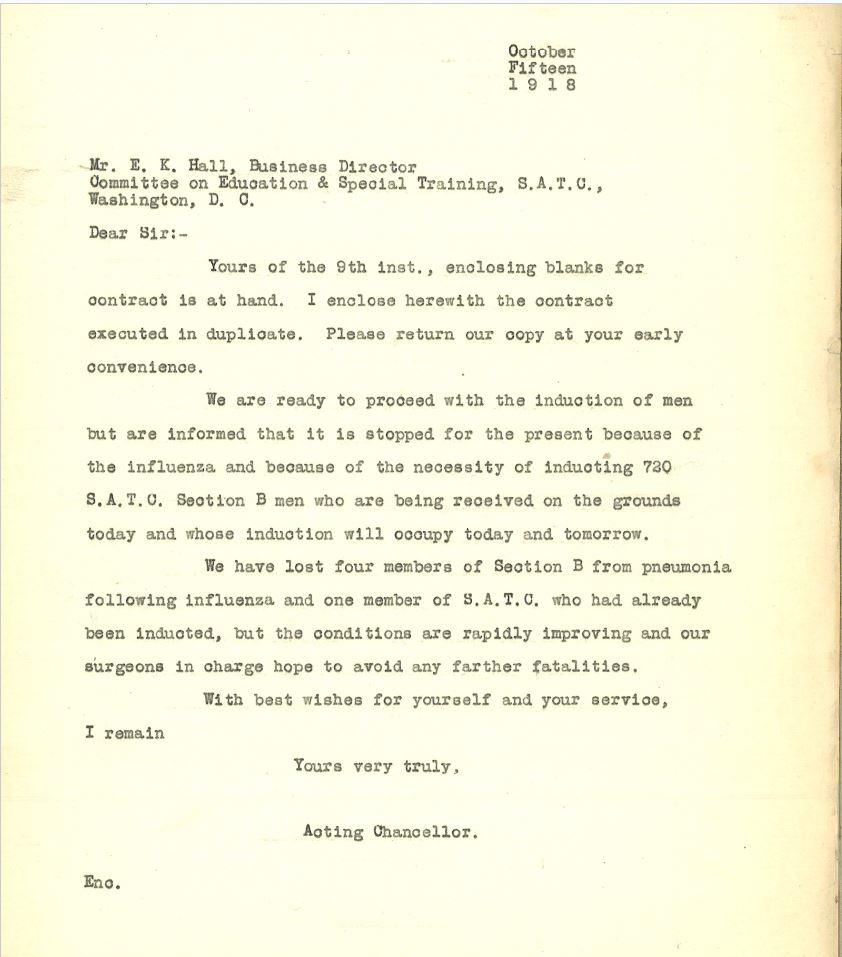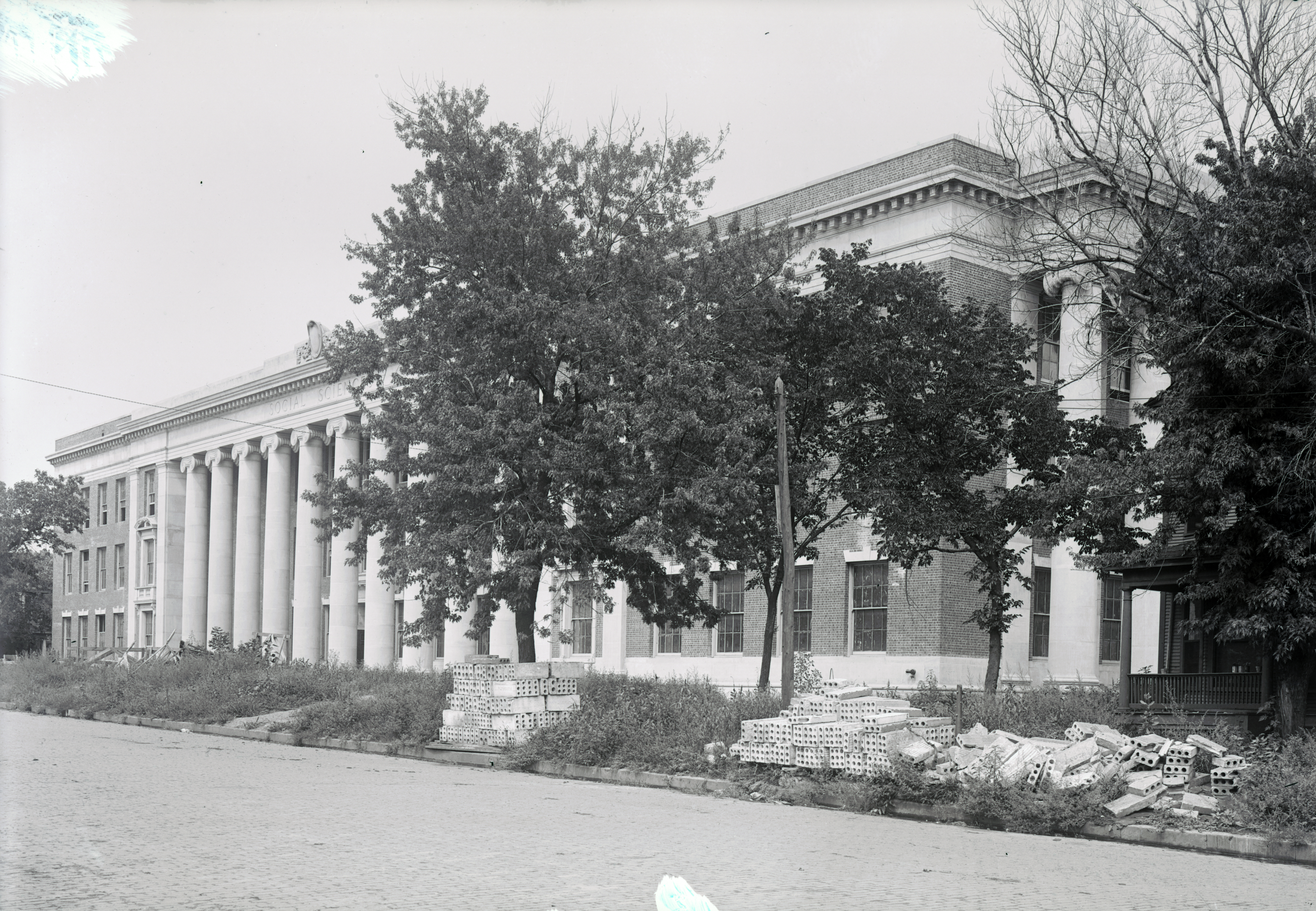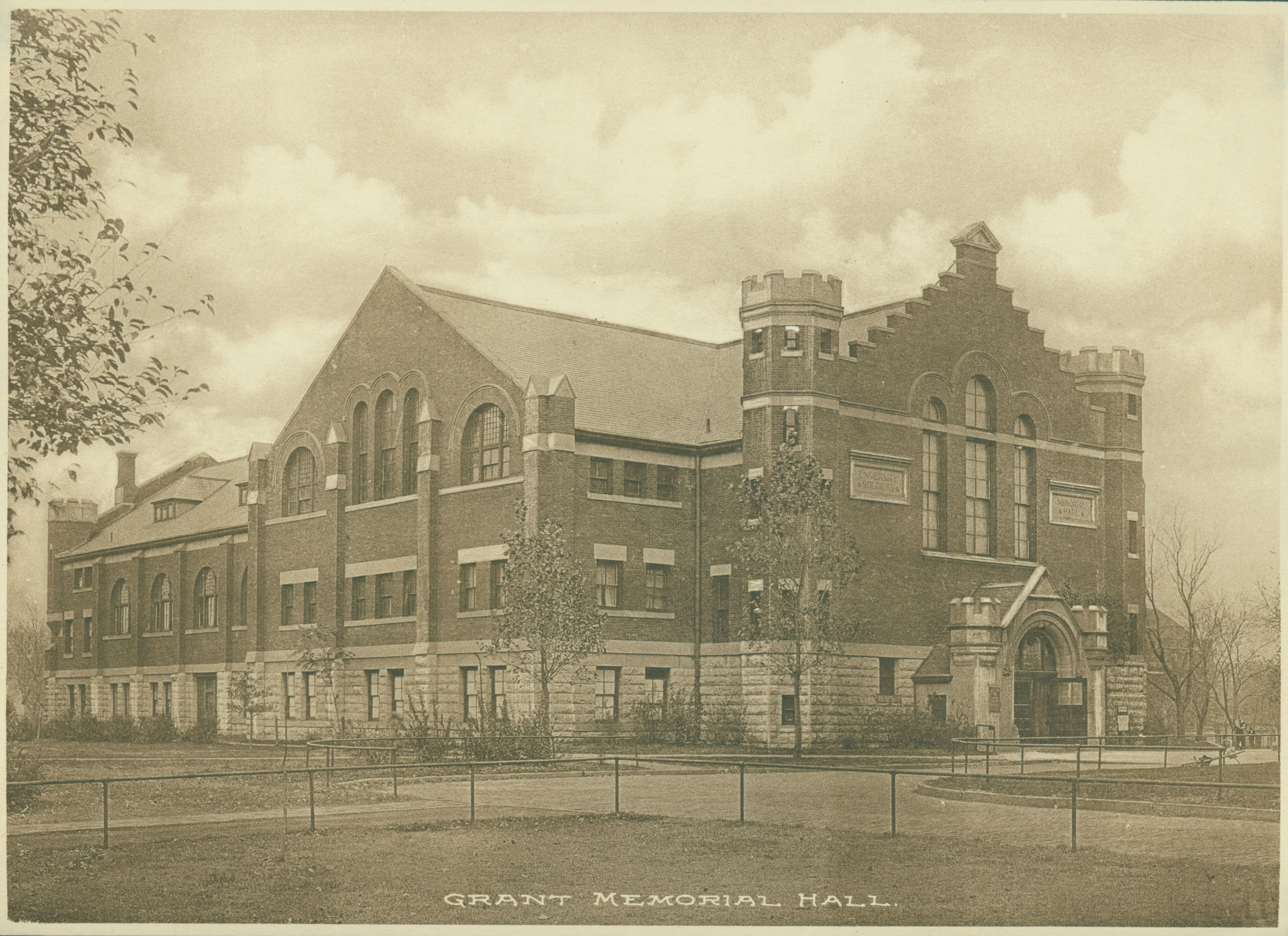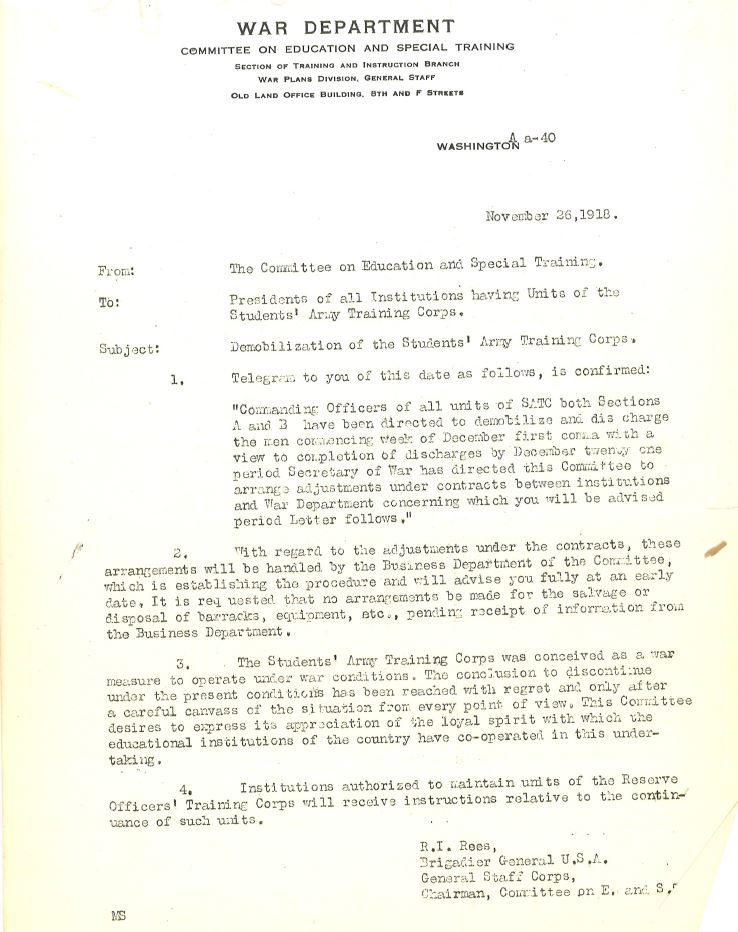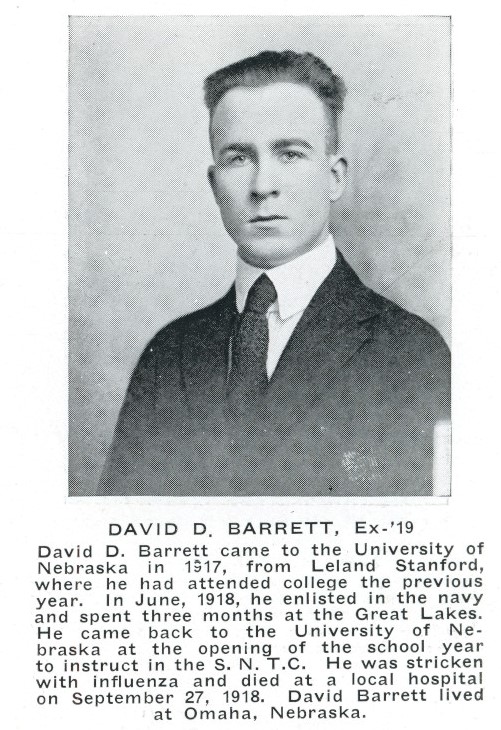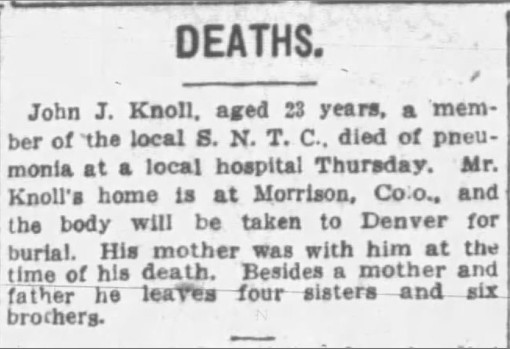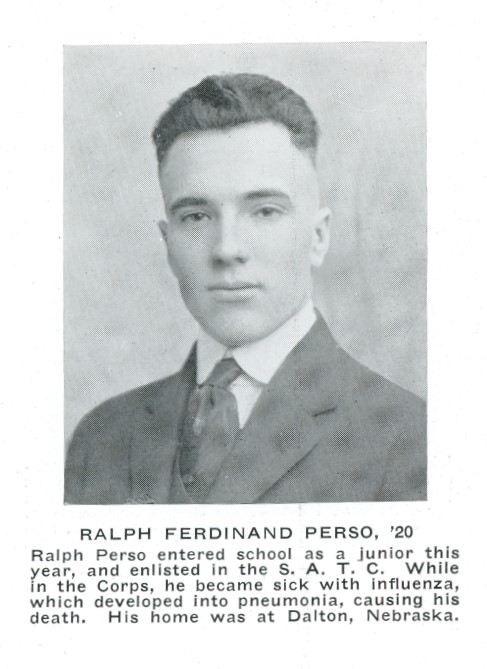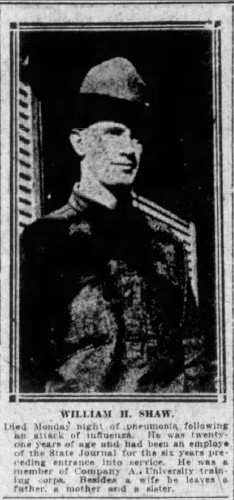The Messenger of Death:
UNL and the Fight against the “Spanish Flu”Campus, Nebraska, & The Flu Timeline
The Arrival
On October 2, 1918, 2,500-3,000 men were officially inducted into the SATC in a ceremony on Nebraska Field (the precursor to Memorial Stadium). The induction ceremony, held simultaneously with over 500 universities across the country, was described as an impressive affair with a military march, band, and over 1,000 people in attendance.
Request for Assignment of Soldiers (page 1)
Reports and General Files, Board of Regents Records (RG 01-01-01). Archives & Special Collections, University of Nebraska-Lincoln Libraries.
A Few Bad Colds & a Threat Against Temple Theatre
This is a very serious matter and should be regarded in a very serious light … unless the thing is grappled with NOW and stamped out right away, it may soon make a ghastly trail on the University campus. It is the solemn duty of everyone to make the most drastic of measures to rid Lincoln of this messenger of death.
Ironically, printed directly under the words “messenger of death,” was an ad for the first football rally of the year. In direct opposition to Dr. Clapp’s list of precautions against crowds, the rally would be held inside Temple Theatre at 11:00 am that same day. An accompanying article warned that the Temple building was doomed to withstand all the enthusiastic fans, and that “Every red-blooded Cornhusker follower will be in his place” ready to celebrate when the ceremonies began with a sure victory against Iowa.
“Spanish Influenza Under Control”
As cases began to increase, an emergency meeting of the Lincoln Committee on Health and Sanitation was called on October 3. Lincoln health officials including the city physician, university training detachment officials, and State Board of Health physician, agreed that although some of the cases were severe, it was not alarming and not abnormal for cases at that time of year. To help fight the spread on campus, Dr. Clapp announced a temporary infirmary had been established to house ninety students, with plans of surrendering other State Farm (currently East Campus) buildings if needed. In addition, the committee also passed a resolution for the Lincoln Commercial Club to aid in the creation of a “more permanent” infirmary for military students.
On October 4, the Daily Nebraskan reported the “Spanish Influenza is Under Control” on campus with only 150 cases and two deaths. Of the cases reported, seventy-five were SATC military students stationed on City Campus, the State Farm, and the Hayward Military Academy, located a few miles outside Lincoln.
Despite the Daily Nebraskan’s report that the flu was “under control,” The Lincoln Star named Lincoln an influenza epicenter with close to 1,000 reported cases and five deaths the next day. At the military camps, health officer Captain A.O. Buck ordered quarantine of SATC men and banned all visitors. However, these measures were too late, as the flu took the lives of four more victims, senior Evangeline Pelton and military students Paul Young, Claudius Wedin, and Rueben Larson on October 8. Within two days, eight emergency infirmaries had been established on or near campus, including several private houses on 12th street and one on the State Farm. Despite five student deaths, eight emergency hospitals, and 300 reported cases on campus, the Daily Nebraskan reported that there was no need to worry as:
“The spread of the disease has not been sufficiently rapid to cause much alarm, and the situation has not been considered serious enough to warrant any action on the part of the regents.”
Classes would continue. However, university officials did fear spread as convocation was rescheduled, major football games were cancelled due to “health conditions,” fraternities were suspended, and all campus dances and social functions were postponed until further notice.
“School Closed by City Council Order”
The city of Lincoln took a more aggressive approach against the spread of influenza. On October 14, going against the suggestions of its own city physician Dr. C.F. Chapman, the Lincoln City Council issued an emergency ban that closed all churches, schools, theatres, dance halls, and public gatherings, effective immediately. Just two weeks after the Daily Nebraskan’s first mention of the flu, classes were cancelled and the university was closed by city order. However, Acting Chancellor Dean Hastings urged students to stay on campus as the city ban was unnecessary and would be quickly lifted. SATC classes were cancelled, but military students were expected to continue to drill and report as normal.
Although the university was closed, newly drafted SATC men continued to arrive on campus and so did influenza. In late October, 720 more SATC students were transferred to the State Farm campus and with them over 100 cases of influenza. On October 21, the Daily Nebraskan reported “influenza was still on the rampage,” and the reopening of the university was uncertain. On October 22, the Nebraska State Health Board agreed and issued a statewide quarantine and ban on all public gatherings until November 2, 1918.
Changes on the Campus “Homefront”
Campus was physically changing too. With the addition of over 2,500 military students on campus, the university needed to find a place to house and feed them. On the State Farm, two large wooden barracks and a mess hall were constructed on campus grounds. On City Campus, the Armory (Grant Memorial Hall), original Nebraska Hall, and newly constructed Social Sciences Hall (now Pound Hall) were converted into barracks, and showers and extra toilets were added for soldier comfort.
To keep up with all the men in the infirmaries and barracks, the Home Economics prep kitchen on State Farm campus was converted into a diet kitchen for the barracks. Head of the Home Economics Department, Margaret Fedde, oversaw student nutrition and carefully constructed diet menus for the sick of up to 500 men across all hospitals on campus. The sickest patients were given a liquid diet and fed a varied diet of broth, cabbage, lemonade, egg nog, oyster soup, grape juice, ice cream, and similar foods five times a day.
Classes, Celebrations, & the “Influenza Menace” Resume
Despite the continued presence of the flu, the university reopened on November 2 with the lifting of the statewide quarantine. Classes, social events, and sports events returned as normal. On November 8, classes were cancelled again but this time for gathering in celebration. The Daily Nebraskan reported “Partial Holiday for Celebration,” the student body will participate in a mass meeting that “will necessarily have to be a dual affair because of the great number that will attend. Neither the auditorium nor any other suitable building in the city could handle the assembly so officials have arranged to hold two mass meetings.” A few days later, on November 11, students and Lincoln residents flooded the streets with loud cheers, an orchestra, and a massive parade in celebration of Armistice Day and the end of the War.
University activity, holidays, large dances, and celebrations continued as normal. On November 28, the Daily Nebraskan reported the “influenza menace bobs up once more” and the “dreaded curse” is again “threatening students of the university.” On December 4, SATC men were once again ordered under quarantine as fifty new cases were reported across city and farm campuses. With the deaths of several more students, fatality rates rose higher than previous outbreaks in October. When over 200 cases were reported on December 11, the university became concerned it would have to cancel classes again. On December 12, The Daily Nebraskan published a message calling for the university to shut down in concern for student health:
It is of the opinion that schools should be closed indefinitely on account of the influenza epidemic which is rapidly become worse, and which demands attention. Our cause for concern is the welfare of the students. If there is anything that can be done to protect the health and lives of students, the Nebraskan thinks that it should be done. So far the measures for preventing the spread of the epidemic have been unsuccessful. The situation approaches a crisis. There is stringent need for more active, preventative measures. If closing school will help, and it seems that such an extremity is the only solution for the exigency at hand, then schools should be closed.
Disbandment
Fortunately, the end of World War I and the semester greatly improved conditions on campus. In mid-December, as the SATC and SNTC disbanded, military students were discharged and sent home. Campus returned “to practically normal again” on December 19, when the semester ended, and students returned home for winter break.
The University of Nebraska resumed classes in January 1919. Although influenza was still present, the cases were isolated, and the Daily Nebraskan did not report any more widespread cases. As a Daily Nebraskan article put it a year after the outbreak:
The old Spaniard, “N. Flu Enza,” wrought sad havoc with every line of school activities not only here, but elsewhere, and we certainly hope that we will be spared from another ordeal like the one through which nearly everyone passed last winter.
The Flu Takes Many Victims
Nebraska’s influenza death records are so inaccurate and incomplete that they were omitted from national totals. It is estimated that between 2,800-7,500 Nebraskans died from the flu, but due to poor record keeping, we will never truly know the real numbers. At the University of Nebraska, the estimated mortality rate was two percent, with forty-eight students dying from pneumonia or other complications caused by the flu. Of these students, five were women and the other forty-three were men and members of the student military training corps.
Their names are:
- David Dean Barrett, SNTC, Sept. 29
- John J. Knoll, SATC Section B, Oct. 3
- Lawrence Sheldon, SATC induction incomplete, Oct. 4
- Gilbert W. Roslund, SATC induction incomplete, Oct. 5
- Paul S. Young, SATC induction incomplete, Oct. 5
- Claudius (also written as Gloudis) B. Wedin, SATC Section B, Oct. 8
- Paul Grossman, SATC induction incomplete, Oct. 8
- Reuben F. Larson, SATC Section B, Oct. 8
- Evangeline Pelton, student, Oct. 8
- John R, Beem, SATC Section B, Oct. 11
- Joseph Campbell, SATC Section B, Oct. 11
- Harry Davis (also written as Henry Davis), Section B, Oct. 11
- William Willis, SATC Section B, Oct. 11
- Daniel R. Zimmerman, SATC Section A, Oct. 11
- Emrich E. Rocke, SATC Section B, Oct. 12
- Albert Baumgartner, SATC induction incomplete, Oct. 13
- Ivan I. Stout, SATC Section B, Oct. 13
- Charles F. Thorpe, SATC Section B, Oct. 13
- William H. Shaw, SATC Section B, Oct. 14
- Lawrence Hitch, SATC induction incomplete, Oct. 16
- Emmett Lynch, SATC Section B, Oct. 17
- Jeannette E. Boyd, student, Oct. 18
- Joseph C. Flaherty, SATC induction incomplete, Oct. 18
- Paul J. Peterson, SATC induction incomplete, Oct. 19
25. Roy E. Stanquist, SATC Section B, Oct. 19
26. Warren F. Birdwell, SATC Section B, Oct. 21
27. Ernest McDonald, SATC Section B, Oct. 24
28. Fred H. DeVore, SATC Section A, Oct. 25
29. William LeRoy Stebbins, SATC Section B, Oct. 28
30. Venia MacDonald, student, Oct. 31
31. Alfred Bratt, SATC Section B, Nov. 1
32. Henry W. Marriner, SATC induction incomplete, Nov. 2
33. John H. Richter, SATC Section B, Nov. 6
34. Ruth Ryons, student, Nov. 24
35. Frank D. Bruning, SATC Section A, Nov. 30
36. Lee B. Ferguson, SATC Section A, Dec. 7
37. Harold T. Sandusky, SATC Section A, Dec. 8
38. Edward W. Stirk, SATC Section A, Dec. 9
39. John G. Cook, SATC Section A, Dec. 10
40. Edward W. Stirk, SATC Section A, Dec. 11
41. Ralph E. Gehring, SNTC, Dec. 11
42. Ralph F. Perso, SATC Section A, Dec. 14
43. Elizabeth Graff, student, Dec. 17
44. Harry L. Lindstrom, SATC Section A, Dec. 18
45. Raymond S. Sweetland, SATC Section A, Dec. 19
46. Howard Dale Everton, SATC Section A, Dec. 24
47. Don L. Rhea, SATC induction incomplete, unknown
48. Herbert E. Van Pater, SATC Section B, unknown
Resources
Samuel Avery, Subject Correspondence, Chancellor Records (RG 05-10-04). Archives & Special Collections, University of Nebraska-Lincoln Libraries.
Biennial Reports to the Governor, Board of Regents Records (RG 01-05-00). Archives & Special Collections, University of Nebraska-Lincoln Libraries.
Reports and General Files, Board of Regents Records (RG 01-01-01). Archives & Special Collections, University of Nebraska-Lincoln Libraries.
“1918 Pandemic (H1N1 virus),” Centers for Disease Control and Prevention.
The Cornhusker. Lincoln, Neb.: University of Nebraska, 1919.
Kristin A. Watkins, “It Came Across the Plains: The 1918 Influenza Pandemic in Rural Nebraska,” Dissertation, University of Nebraska Medical Center, Omaha, 2015.
Newspapers (chronological)
“Omaha Naval Student Dies at Nebraska University,” Omaha Bee, September 29, 1918.
“Student Dies After Illness of 48 Hours,” Daily Nebraskan, September 30, 1918.
“How to Guard Against Spanish Influenza,” Daily Nebraskan, October 1, 1918.
“Spanish Influenza Makes Appearance at University,” Daily Nebraskan, October 1, 1918.
“Campus Battles with Influenza,” Daily Nebraskan, October 2, 1918.
“Three Thousand Swear Fidelity,” Daily Nebraskan, October 2, 1918.
“Twenty-Five New Cases Spanish Flu,” Daily Nebraskan, October 3, 1918.
“Temple Threatened with Destruction,” Daily Nebraskan, October 3, 1918.
“All Cases to be Isolated: Steps Taken to Stop Spread of Spanish Influenza but no Cause for Alarm, Doctors State-Epidemic not as Serious as Has been Painted,” Lincoln Journal Star, October 3, 1918.
“Plan to Isolate Influenza Patients to Check Epidemic,” The Lincoln Star, October 3, 1918.
“Physicians Say Epidemic Here is Not serious,” The Lincoln Star, October 3, 1918.
“Spanish Influenza Under Control,” Daily Nebraskan, October 4, 1918.
“City Takes Steps to Prevent Any Epidemic Here,” Omaha Bee, October 5, 1918.
“Spanish Influenza Unchecked,” Lincoln Star, October 5, 1918.
“Flu Epidemic Now Believed Under Control,” Omaha Bee, October 6, 1918.
“Council Acts on Influenza Crisis,” Lincoln Star, October 7, 1918.
“Send Nurses and Supplies,” Nebraska State Journal, October 8, 1918.
“Paul Young Falls Victim,” Daily Nebraskan, October 8, 1918.
“Social Functions are Suspended this Week,” Daily Nebraskan, October 8, 1918.
“Epidemic Not Yet Cause for Concern,” Daily Nebraskan, October 9, 1918.
“New Hospitals are Established,” Daily Nebraskan, October 10, 1918.
“Influenza Takes One More Victim,” Daily Nebraskan, October 11, 1918.
“Funston-Husker Game Cancelled: Health Conditions Here Prevent Invasions of Soldiers,” Daily Nebraskan, October 12, 1918.
“Closing Order in Force in Lincoln,” Lincoln Journal Star, October 12, 1918.
“Program Discontinued,” The Lincoln Star, October 12, 1918.
“School Closed by City Council Order,” Daily Nebraskan, October 14, 1918.
“SATC Men Detailed to Prepare Barracks,” Daily Nebraskan, October 18, 1918.
“Backbone Breaking at Nebraska Post,” Lincoln Journal Star, October 21, 1918.
“Influenza Still on the Rampage,” Daily Nebraskan, October 21, 1918.
“Quarantine Ban on the Entire State Until November 2,” Lincoln Star, October 21, 1918.
“Entire State Now Under Quarantine,” Daily Nebraskan, October 22, 1918.
“Influenza Now Under Control,” Daily Nebraskan, October 24, 1918.
“War Time Housekeeping,” The Nebraska State Journal, October 27, 1918.
“S.A.T.C. Classes start Wednesday,” Daily Nebraskan, October 29, 1918.
“Gov. Recommendations Hit Fraternities Hard,” Daily Nebraskan, November 1, 1918.
“Uni Doors Swing Open Once More,” Daily Nebraskan, November 4, 1918.
“Armistice Causes Gloom; Then Joy,” Daily Nebraskan, November 8, 1918.
“Partial Holiday for Celebration,” Daily Nebraskan, November 8, 1918.
“Huskers Welcome Advent of Peace,” Daily Nebraskan, November 12, 1918.
“Influenza Menace Bobs up Once More,” Daily Nebraskan, November 28, 1918.
“SATC Unit Will be Demobilized Next Week,” Daily Nebraskan, November 28, 1918.
“Influenza Runs Rife on Campus,” Daily Nebraskan, December 5, 1918.
“Influenza Still Rages on Campus,” Daily Nebraskan, December 11, 1918.
“Epidemic Shows Improvement,” Daily Nebraskan, December 12, 1918.
“Closing of School Remains Uncertain,” Daily Nebraskan, December 13, 1918.
“Disbanding Nears Completion Here,” Daily Nebraskan, December 16, 1918.
“Number of Influenza Cases Somewhat Less,” Daily Nebraskan, December 16, 1918.
“Christmas Vacation Commences Saturday,” Daily Nebraskan, December 19, 1918.
“Influenza Made Drive a Year Ago,” Daily Nebraskan, October 29, 1919.
Information about student deaths was taken from the following sources:
“Find a Grave,” database, Find a Grave (accessed December, 2020).
“Nebraska, Lancaster County, Wyuka Cemetery Burial Permits, 1883-1999,” database. FamilySearch (accessed December, 2020).
Newspapers (1918):
Albion Argus (Albion, NE)
Atkinson Graphic (Atkinson, NE)
Bancroft Blade (Bancroft, NE)
Battle Creek Enterprise (Battle Creek, NE)
Beatrice Daily Express (Beatrice, NE)
Bladen Enterprise (Bladen, NE)
Blue Hill Leader (Blue Hill, NE)
Clay County Republican (Clay Center, NE)
Columbus Telegram (Columbus, NE)
Crete Vidette (Crete, NE)
Craig News (Craig, NE)
Crofton Journal (Crofton, NE)
Custer County Chief (Broken Bow, NE)
Daily Nebraskan (Lincoln, NE)
Edgar Post (Edgar, NE)
Elgin Review (Elgin, NE)
Enterprise (Blair, NE)
Farnam Echo (Farnam, NE)
Fremont Tribune (Fremont, NE)
Genoa Leader Times (Genoa, NE)
Gothenburg Independent (Gothenburg, NE)
Hamilton County Register (Aurora, NE)
Lincoln Journal Star (Lincoln, NE)
Lincoln Star (Lincoln, NE)
Nebraska Signal (Geneva, NE)
Nebraska State Journal (Lincoln, NE)
Omaha Bee (Omaha, NE)
Plattsmouth Journal (Plattsmouth, NE)
Public Mirror (Arapahoe, NE)
Credits
Exhibit created by Archives Specialist, Katie Jones, December 2020.

